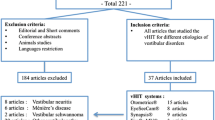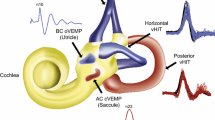Abstract
Purpose
Suppression head impulse testing (SHIMP) is a new vestibular method capable of quantifying vestibular function. The aim of this study was to evaluate the feasibility of this test in patients with existing or newly diagnosed vestibular schwannoma (VS) patients by comparing the results with the traditionally used video head impulse test (vHIT or HIMP).
Methods
Fifty-five patients with unilateral VS underwent a wide battery of audiological and vestibular tests. HIMP results were evaluated using newly introduced objective guidelines based on the trace evaluation of pathological saccades. The sensitivity and specificity of HIMP and SHIMP were evaluated and compared. A new SHIMP parameter is presented; the anticompensatory saccade amplitude ratio (ASAR).
Results
We found a marked increase in specificity in HIMP testing using the objective guidelines. SHIMP testing revealed a gain threshold of 0.7 to be optimal in terms of achieving high specificity and sensitivity in relation to HIMP testing. Significant correlations were found between a low ASAR and a high degree of vestibular pathology.
Conclusion
The SHIMP test is a viable addition to the standard HIMP test in patients with VS, especially with the addition of the ASAR, which could prove useful in monitoring the residual vestibular function.
Trial registration number and date of registration
N/A.

Similar content being viewed by others
Data availability
All data are stored and registered in the electronic data capture systems provided by the manufacturers and stored in the Regional Electronic Data Record Systems provided by the University Hospital.
Code availability
All codes used are commercially available.
References
Goldbrunner R, Weller M, Regis J, Lund-Johansen M, Stavrinou P, Reuss D, et al. EANO Guideline on the diagnosis and treatment of vestibular schwannoma. Available from: https://academic-oup-com.zorac.aub.aau.dk/neuro-oncology/advance-article/doi/https://doi.org/10.1093/neuonc/noz153/5555902
Taylor R, Kong J, Flanagan S, Pogson J, Croxson G, Pohl D, et al. Prevalence of vestibular dysfunction in patients with vestibular schwannoma using video head-impulses and vestibular-evoked potentials. 2015 262(5):1228–37. Available from: https://www.ncbi.nlm.nih.gov/pubmed/25794859
Lees KA, Tombers NM, Link MJ, Driscoll CL, Neff BA, Van Gompel JJ et al (2018) Natural history of sporadic vestibular schwannoma: a volumetric study of tumor growth 159(3):535–542. https://doi.org/10.1177/0194599818770413
Sass HCR, West N, Møller MN, Cayé-Thomasen P. (2018) [Workup and treatment of vestibular schwannomas]. 10 180(37).
Riska KM, Murnane OD (2018) Chapter 8—the video head impulse test. Elsevier Inc. 13 p. (Dizziness and Vertigo Across the Lifespan)
Van de Berg R, Rosengren S, Kingma H (2018) Laboratory testing of the vestibular system. 31(1):425–30. Available from: https://www.ncbi.nlm.nih.gov/pubmed/20717033
Halmagyi GM, Chen L, MacDougall HG, Weber KP, McGarvie LA, Curthoys IS (2017) The video head impulse test. Available from: https://www.frontiersin.org/articles/https://doi.org/10.3389/fneur.2017.00258/full
MacDougall H, McGarvie L, Halmagyi G, Rogers S, Manzari L, Burgess A, et al. (2016) A new saccadic indicator of peripheral vestibular function based on the video head impulse test. 87(4):410–8. Available from: https://search.proquest.com/docview/1807534031
Rey-Martinez J, Yanes J, Esteban J, Sanz R, Martin-Sanz E. (2017) The role of predictability in saccadic eye responses in the suppression head impulse test of horizontal semicircular canal function. 8:536. Available from: https://www.ncbi.nlm.nih.gov/pubmed/29093698
Rey‐Martinez J, Thomas‐Arrizabalaga I, Espinosa‐Sanchez JM, Batuecas‐Caletrio A, Trinidad‐Ruiz G, Matiño‐Soler E, et al. (2018) Vestibulo‐ocular reflex gain values in the suppression head impulse test of healthy subjects. 128(10): 2383–9. Available from: https://onlinelibrary.wiley.com/doi/abs/https://doi.org/10.1002/lary.27107
Jacobson GP, Newman CW. The development of the Dizziness Handicap Inventory [Internet]. US: American Medical Association; 1990. p. 424–424–7. (Archives of Otolaryngology—Head and Neck Surgery; vol. 116). Available from: https://sfx.aub.aau.dk/sfxaub?sid=Entrez:PubMed&id=pmid:2317323
Hallgren G, Bockhoff LB. The Dizziness Handicap Inventory (DHI) Translation into Danish and test of the Danish version on ten patients with dizziness. University College Sealand 2008.
Y Amy, W Irene, V Salomi, C Stephanie, MS K-J Tammie, (2013) Measurement characteristics and clinical utility of the dizziness handicap inventory among individuals with vestibular disorders. 94(11): 2313–4. Available from: https://www.clinicalkey.es/playcontent/1-s2.0-S0003999313005388
Hougaard DD, Abrahamsen ER (2019) Functional testing of all six semicircular canals with video head impulse test systems. (146). Available from: https://www.jove.com/59012
Abrahamsen E, Christensen A-E, Hougaard D (2018) Intra and interexaminer variability of two separate video head impulse test systems assessing all six semicircular canals. 39(2):e113–22. Available from: http://ovidsp.ovid.com/ovidweb.cgi?T=JS&NEWS=n&CSC=Y&PAGE=fulltext&D=ovft&AN=00129492-201802000-00022
Harris PA, Taylor R, Thielke R, Payne J, Gonzalez N, Conde JG (2009) Research electronic data capture (REDCap)—a metadata-driven methodology and workflow process for providing translational research informatics support. 42(2):377–81. Available from: https://www.sciencedirect.com/science/article/pii/S1532046408001226
Aalling M, Skals RK, Abrahamsen ER, Hougaard DD (2020). Comparison of test results from two separate video head impulse test systems in a cohort of patients diagnosed with a unilateral vestibular schwannoma. Available from: https://search.proquest.com/docview/2415834205
Hentschel M, Scholte M, Steens S, Kunst H, Rovers M (2017) The diagnostic accuracy of non-imaging screening protocols for vestibular schwannoma in patients with asymmetrical hearing loss and/or unilateral audiovestibular dysfunction: a diagnostic review and meta-analysis. 42(4):815–23. Available from: https://search.datacite.org/works/https://doi.org/10.1111/coa.12788
Wagner J, Glaser M, Wowra B, Muacevic A, Goldbrunner R, Cnyrim C, et al. (2011) Vestibular function and quality of life in vestibular schwannoma: does size matter?. Available from: https://www.frontiersin.org/articles/https://doi.org/10.3389/fneur.2011.00055/full
Kjærsgaard J, Szeremet M, Hougaard D (2019) Vestibular Deficits Correlating to Dizziness Handicap Inventory Score, hearing loss, and tumor size in a Danish cohort of vestibular schwannoma patients. 40(6):813–9. Available from: https://www.ncbi.nlm.nih.gov/pubmed/31135674
Funding
None.
Author information
Authors and Affiliations
Contributions
All authors made substantial contributions to the conception or design of the work; or the acquisition, analysis, or interpretation of data; or the creation of new software used in the work. Drafted the work or revised it critically for important intellectual content. Approved the version to be published and agree to be accountable for all aspects of the work in ensuring that questions related to the accuracy or integrity of any part of the work are appropriately investigated and resolved.
Corresponding author
Ethics declarations
Conflicts of interest
The authors declare that they have no conflicts of interest.
Ethical approval
N/A. Complete video Head Impulse Testing with both HIMP and SHIMP test protocols and fulfillment of the Dizziness Handicap Questionnaire is part of the standard clinical evaluation of patients diagnosed with a vestibular schwannoma and the equipment used in this study is already approved for clinical testing. Furthermore, no patients had to undergo randomization to additional treatments or examinations. Therefore, a formal application to the North Denmark Region Committee on Research Ethics was not deemed necessary.
Consent to participate
All subjects were thoroughly informed about both types of vHIT testing prior to testing.
Additional information
Publisher's Note
Springer Nature remains neutral with regard to jurisdictional claims in published maps and institutional affiliations.
Rights and permissions
About this article
Cite this article
Jensen, M.K., Hougaard, D.D. Suppression head impulse testing is recommended for vestibular testing of patients with untreated unilateral vestibular schwannoma. Eur Arch Otorhinolaryngol 279, 91–99 (2022). https://doi.org/10.1007/s00405-021-06621-y
Received:
Accepted:
Published:
Issue Date:
DOI: https://doi.org/10.1007/s00405-021-06621-y




